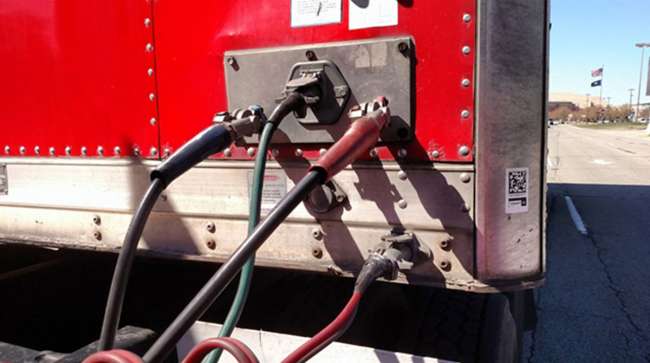The Tractor-to-Trailer Interface

[Stay on top of transportation news: Get TTNews in your inbox.]
Ever since digital antilock braking systems were mandated in the mid-1990s, an ever-increasing array of electrically powered, data-networked technologies have placed increased demands on the tractor electrical system and databus.
One thing trucking got right when the ABS mandate emerged, however, was preserving the standard tractor-to-trailer interface — the J560 seven-pin connector — albeit with supplemental power-line carrier multiplexing. Multiplexing allowed multiple signals to be carried on a single electrical circuit, paving the way for greater trailer-trailer electrical communication.

Legler
To prevent incompatibilities and proprietary interfaces, the trucking industry worked to keep this important standard to facilitate interoperability and connectivity across fleets and various manufacturers’ equipment.
American Trucking Associations’ Technology & Maintenance Council and its members strongly supported and contributed to the development of the SAE J560 primary and auxiliary connectors and the related cabling for 12-volt systems. Multiplexing was anticipated to meet the needs for trailer systems for several decades.
However, a vast array of advancements — electric and highly automated vehicles, telematics, solar power, two-way power flow, regenerative trailer braking and electromechanical braking means that 24-volt and even 48-volt systems will be needed to support more complex tractor-to-trailer connectivity options. As a result, we know how to start thinking about the tractor-trailer combination as an integrated whole vehicle, rather than as the tractor and trailer simply hooked together. Multivoltage systems are likely to be commonplace in less than 10 years.
SAE International’s Truck and Bus Council has initiated a review of the tractor-to-trailer interface. The council has communicated with TMC on this effort as many of the experts in this field are active on task forces of both organizations.
TMC’s Future Truck Committee has developed several documents. These include TMC Future Truck Position Paper 2017-4 — Recommendations Regarding Multi-Voltage Vehicle Electrical Systems; and, TMC Information Report IR 2015-3 — Exploring the Potential for 48-Volt Commercial Vehicle Electrical Systems, which identify core principles for developing requirements for future standardized systems.
TMC’s key considerations include:
• Expansion of telematics, electric trailer refrigeration units, trailer power generation and development of the electric truck segment mean greater power demands likely exceeding 12 volts, which would lead to 24 volts or likely 48 volts over time. If the latter is the ultimate outcome, it is important to strategically position connectivity standards to this end.
• There is a danger that “proprietary” solutions will work against the current interchangeability among power units/trailers/dollies that was the result of years of “dialogue” decades ago. Originally, every manufacturer was to have its own proprietary databus with no consideration of interoperability until fleet users working through TMC/ATA and other groups forced standardization.
• Any future connectivity standardization needs to be backward compatible, multivoltage and accessible to systems and equipment designers.
TMC and SAE support looking into an option for a 24-volt or 48-volt connector that must be keyed so that they cannot be connected to each other or to the SAE J560 connector. That’s because there are more trailers than tractors that will remain in service for decades, and every effort should be made that any tractor — regardless of its system voltage — can be connected to any 12-volt trailer. Because of the need for a reliable command circuit for ABS and other automated safety systems, any future connectivity developments must maintain safety as the priority. Any new 12-volt connections must be backward compatible to avoid the overstocking of parts inventory to service multiple designs and associated cabling.
SAE and TMC’s Future Truck Committee are evaluating automated connectivity in conjunction with automated coupling systems currently being developed.
Tractor-to-Trailer Connectivity Task Forces
At its 2019 Fall Meeting in Raleigh, N.C., in September, TMC determined that the rapidly changing tractor-trailer combination as an integrated whole will require an evolution of engineering specification and maintenance practices that parallels the technical design standard reviews currently underway within SAE and international mobility standards organizations. To this end, TMC’s S.1 Electrical and S.7 Trailers, Bodies and Material Handling study groups jointly recommended establishing two new task forces titled “Next Generation Tractor-to-Trailer Electrical Interface.”
The electrical-oriented task force will address power and physical connectivity issues. The trailer counterpart will address meeting the energy and data communication network requirements of the technologies currently in production and those anticipated coming into service in the near future.
These task forces will work collaboratively with other TMC study groups and in liaison with outside standards organizations. Many of the subject matter experts who will be involved in the TMC effort also are engaged in the development work of those other organizations.
Paul Menig, CEO of Business Accelerants, a TMC associate member and Silver Spark Plug recipient, will chair both task forces. Fleet representatives and subject matter experts from manufacturers and suppliers are strongly encouraged to contribute. Those interested can join these Task Force Communities on TMC Connect (tmcconnect.trucking.org) or contact Menig via email at paul@businessaccelerants.com.
TMC & PIT Group Launch Research Projects

In our third episode of RoadSigns, Season Four, we ask: Onboard Video: What Really Happened Out on the Road? Hear a snippet from host Seth Clevenger, above, and get the full program by going to RoadSigns.TTNews.com.
TMC also initiated research projects to kick off its new research partnership with PIT Group-FPInnovations of Quebec.
In looking toward the potential for new safety technologies in tractor-trailer combinations as a connected whole, one research project involves exploring the state of development for electromechanical braking systems (EMBs) for heavy-duty commercial vehicles. TMC’s Future Truck Committee identified this technology, which would replace standard air disc brakes with electric-motor driven, electronically controlled disc braking componentry.
TMC asked PIT Group to contact the major braking system suppliers and original equipment manufacturers to identify the state of design, prototype development and any testing data that may be available. It involved identifying challenges regarding power and electronic data (command and control) circuits through the tractor-to-trailer interface.
The Future Truck Committee will review FPInnovations’ report to make recommendations regarding a potential second phase of this project to conduct tests to determine if EMBs perform as well or better than current pneumatic reduced stopping distance (RSD) braking systems.
More information on the subjects addressed in this column can be directed to me at jlegler@trucking.org.
Jack Legler manages TMC’s recommended practice development process.
Want more news? Listen to today's daily briefing:




